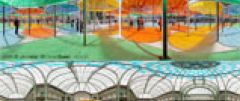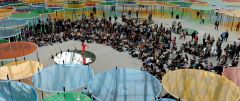Situated work
A work in situ, closely linked to the place in, for and in relation to which it was designed, is, by definition, site-specific. But there is second series of works that can be moved according to ad hoc rules: Daniel Buren calls them “situated works.”
From the outset, his works on striped canvas, although in many ways close to painting, were always accompanied by precise instructions on the way they were to be shown when exhibited in another venue. The idea was clarified in 1975 when the museum in Mönchengladbach, Germany, where Daniel Buren had just exhibited a piece, had to move and transport his work to a new building. The question of how the works could be transferred to a new venue was then addressed.
Just as certain pieces of conceptual art can be “performed” in other contexts, so situated works can be played out in other places, as long as the principles laid down by the artist are respected. But unlike conceptual art, the work cannot be reduced to these instructions. It exists only physically, in a space.
Most of the Exploded Huts, for example, are situated works: they are arrangements that are inseparable from a particular environment but can be adapted to an infinite number of different situations. The work changes each time, just as it transforms the site.
But Daniel Buren insists that these works cannot be put “just anywhere,” and that is part of his struggle against the “artwork’s so-called independence.” There are rules to be applied and a type of space to be used: situated works are mobile works, which can be seen in various combinations and versions.
The theatre seems to be the most pertinent metaphor for the principle of his situated works. Each installation is like the performance of a play: the text has not changed, but the staging and sets have nothing to do with the original performance and have a huge impact on our appreciation of the play and the look of the stage.





